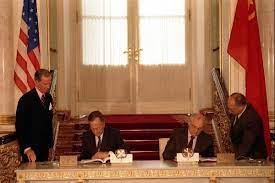The START Treaty, or Strategic Arms Reduction Treaty, is an important agreement between the United States and Russia aimed at reducing the number of nuclear weapons held by both countries. This treaty has been in effect since 2011 and has played a crucial role in maintaining global stability and reducing the risk of nuclear conflict.

Table of Contents
Background of START Treaty
The Treaty was originally signed in 1991, but it expired in 2009. Negotiations for a new treaty began in 2009, and the new START Treaty was signed in April 2010. It was later ratified by both the United States Senate and the Russian Duma, and it entered into force on February 5, 2011.
Key Provisions of START Treaty
The Treaty sets limits on the number of nuclear weapons that both the United States and Russia are allowed to possess. The treaty limits each country to no more than 1,550 deployed warheads, 700 deployed missiles and bombers, and 800 deployed and non-deployed missile launchers and bombers. It also includes provisions for verification and inspection to ensure compliance.
Implications of START Treaty
The Treaty has had significant implications for global security. By reducing the number of nuclear weapons held by the United States and Russia, the treaty has reduced the risk of accidental nuclear war or nuclear conflict. It has also helped to build trust between the two countries and paved the way for further arms control agreements.
Criticism
Despite its many benefits, the START Treaty has also faced criticism from some quarters. Some critics argue that it does not go far enough in reducing nuclear weapons, and that it should include other nuclear-armed countries such as China. Others argue that it places too much emphasis on verification and inspection, and that it is difficult to enforce.
Conclusion
Overall, the Treaty represents an important milestone in the ongoing efforts to reduce the threat of nuclear war and promote global stability. While it has faced criticism and challenges, it remains an essential agreement that has helped to reduce the number of nuclear weapons held by the United States and Russia, and has contributed to a more peaceful world.
Important Links